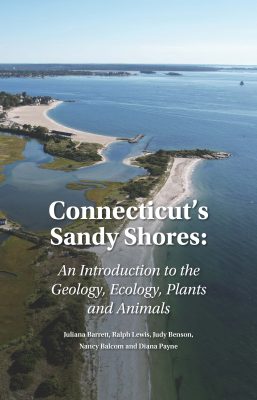 Connecticut Sea Grant and the Connecticut College Arboretum are pleased to announce the publication of Connecticut’s Sandy Shores: An Introduction to the Geology, Plants and Animals, a 130-page guidebook with dozens of color photos and illustrations along with explanatory text about the ecology, geology, common species and why Connecticut’s sandy beaches differ from many others along the Atlantic seaboard.
Connecticut Sea Grant and the Connecticut College Arboretum are pleased to announce the publication of Connecticut’s Sandy Shores: An Introduction to the Geology, Plants and Animals, a 130-page guidebook with dozens of color photos and illustrations along with explanatory text about the ecology, geology, common species and why Connecticut’s sandy beaches differ from many others along the Atlantic seaboard.
Printed on water resistant paper, the book is intended as an educational companion for visits to the shoreline by anyone interested in learning about the coastal environment, including formal and informal educators, birders, artists, students and the general public.
“Our hope in developing this guide is that people can take this guide to the beach in any season and appreciate and understand this highly dynamic system, especially in light of the changing climate and its impacts on Connecticut’s shoreline,” said Juliana Barrett, CT Sea Grant coastal habitat specialist, UConn extension educator and lead author.
Barrett oversaw creation of the book, which includes a main section written by retired State Geologist Ralph Lewis, and contributions from CTSG Associate Director Nancy Balcom, Communications Coordinator Judy Benson and Education Coordinator Diana Payne. Content was reviewed by local subject matter experts and numerous photographers provided eye-catching bird, invertebrate, plant and aerial photos. A centerfold painted by artist John Sargent of Waterford shows a composite of the various elements of the shoreline environment, from coastal forest to dunes to the water’s edge.
“My goal in writing the geology section of the book was to emphasize that successful, local coastal resilience initiatives must be based on a recognition that the geology and physical functioning of the Connecticut coast differs markedly from surrounding Atlantic-facing, sand-rich coastlines,” Lewis said. “Just because it worked in one location, don’t count on it working in another unless your design has factored in all the local geologic and oceanographic processes currently reshaping your prospective site.”
Funding for production and printing of the book was provided by CT Sea Grant, the Arboretum and the National Oceanic and Atmospheric Administration (NOAA). It is a companion to a previous CT Sea Grant-Arboretum publication, Salt Marsh Plants of Long Island Sound.
“We are excited for the publication of this new field guide,” said Maggie Redfern, director of the Connecticut College Arboretum. “It is a great resource for anyone curious to learn more about our beautiful shoreline as well as those interested in landscaping with native plants along the Connecticut coast. We also hope that it will inspire more people to develop an appreciation for the conservation of the diverse flora, fauna and geology of this unique landscape.”
Copies will be available for $18 plus postage costs by sending a request to: trz24001@uconn.edu or to: arbor@conncoll.edu
A webinar about Connecticut’s Sandy Shores led by Juliana Barrett and Ralph Lewis can be found here.